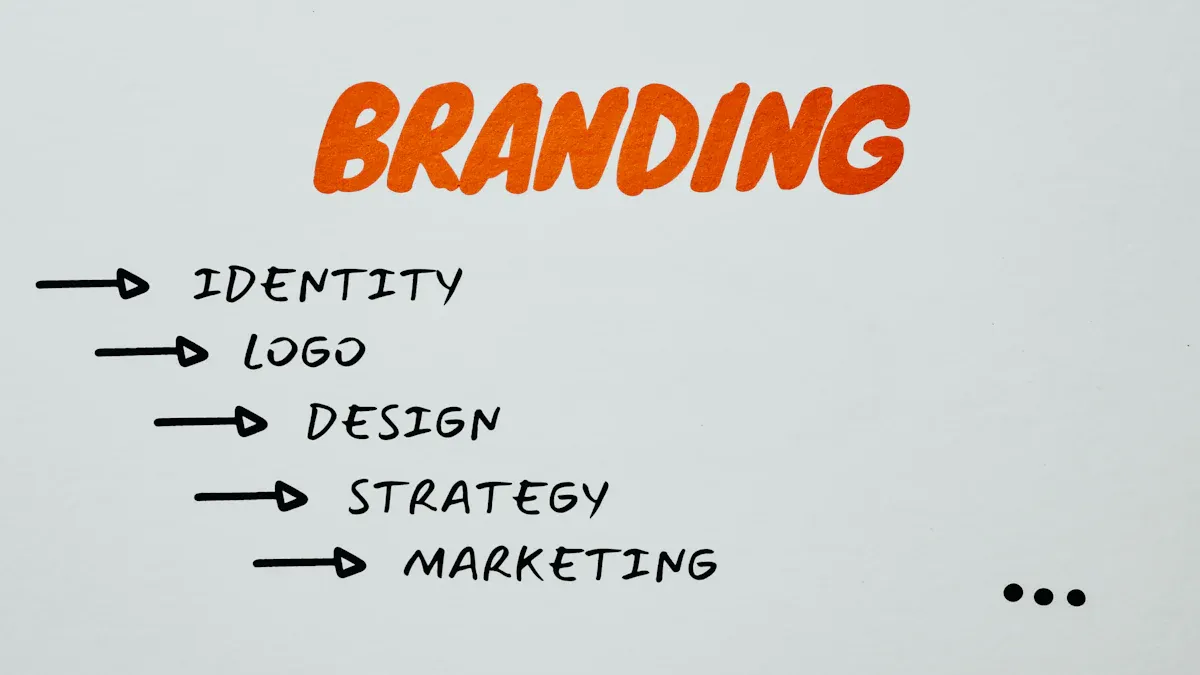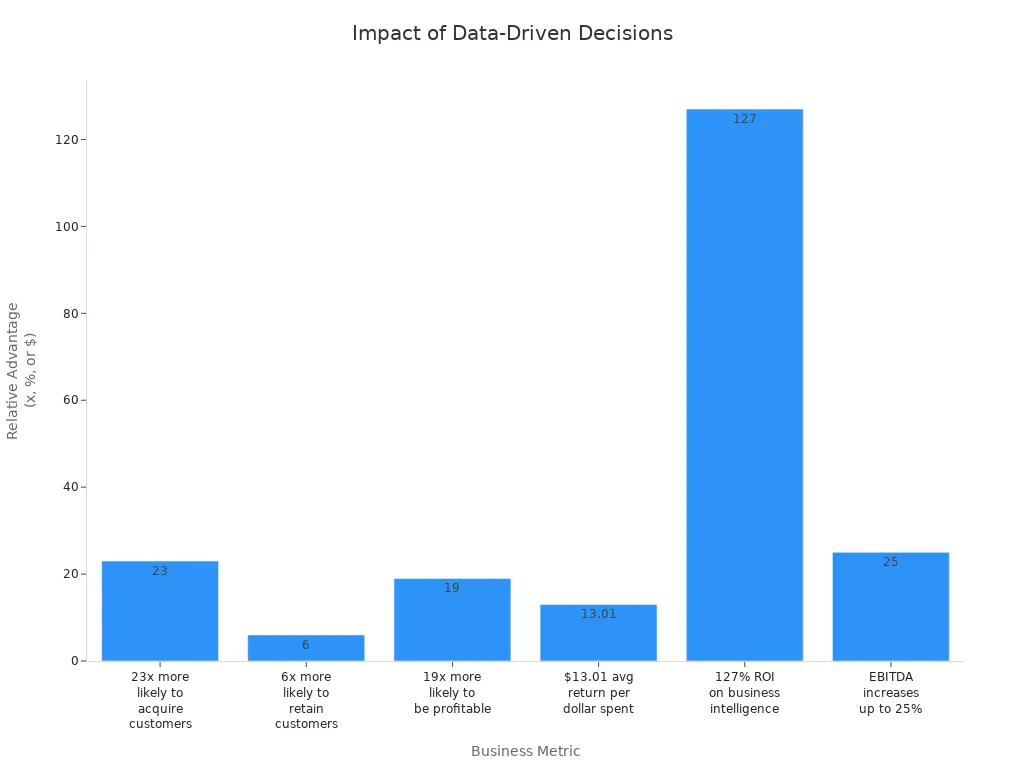
Competing with established brands never felt this possible
Table Of Contents

Competing with established brands is possible for any new business that uses business innovation and agility. Many studies show that innovation gives an advantage in a busy market. Agility, with help from dynamic capabilities and information technologies, lets companies react fast to competition.
Research shows that companies with high flexibility and a focus on innovation can change and find new chances during fast market changes.
Managers who use alertness protocols and strategic agility have a better chance to stand out.
New businesses often face tough competition, not enough resources, and must build trust. But business innovation lets them give special value and get noticed. A busy market hides chances for people who think in new ways and act bravely. Business innovation, creativity, and quick changes help any company grow and win.
Key Takeaways
New businesses can win by finding market gaps. They offer special value that big brands do not see.
A clear and simple unique selling proposition helps get the right customers. It also helps build loyalty.
A strong brand identity and good storytelling build trust. They help people remember a business in a busy market.
Using digital tools and data helps startups reach customers faster. It also helps them make better choices.
Personalized experiences and building a community keep customers interested. Quick marketing tests help brands grow.
Unique Edge in a Crowded Market
Market Gaps
Every business wants to stand out in a busy market. New companies need to find market gaps for good chances. Market gaps happen when customer needs are not met by current products. Startups find these gaps by listening to what customers complain about and checking what big brands miss.
Some customer groups, like people in rural areas or certain ages, are often ignored by big companies.
Missing features or services show up in user feedback and point out where products do not work well.
Bad customer service, slow help, or confusing websites give new businesses a chance to use business innovation.
New companies can work faster or cheaper to beat others.
Successful companies like Slack, HubSpot, and Zoom used business model innovation to fill these gaps. Slack made work chats easy. HubSpot put marketing tools together. Zoom made video calls simple and reliable. These companies listened to customers and made things better without making users change too much.
Startups use different ways to find market gaps:
They make buyer personas by talking to customers and learning about their problems.
They study the competition with SWOT analysis and Porter’s Five Forces to find groups that are not served.
They check ideas by looking at data and feedback so they can change quickly.
They make sales guesses and update their market checks often to stay flexible.
Tip: Market gap analysis helps startups use their small resources on the best chances. This gives them a competitive edge over big brands that move slowly.
Focus Area | |
|---|---|
Product line gap | Finds missing products that people want. |
Distribution gap | Looks at how products get to customers and what customers like. |
Usage gap | Checks how people use products and how they could use them better. |
Competitive gap | Compares company products with others to stay strong. |
Profit gap | Looks at the difference between what a company earns and what it wants to earn. |
Manpower gap | Checks if the company has enough workers with the right skills. |
Business innovation works best when companies look for needs that are not met. By giving special value and making customers happy, startups can turn market gaps into ways to grow.
Defining Your USP
A unique selling proposition (USP) makes a business different from others. In a busy market, a clear USP shows special value and brings the right customers. Companies must say what makes them special and why people should pick them over big brands.
To make a strong USP, businesses do these things:
Study competitors by listing what customers like and dislike about them. Check their sales steps and find needs that are not met.
Find market gaps by talking to customers and looking at data.
Make the USP with a simple plan: “We help [AUDIENCE] get [CHANGE] with [PRODUCT/SERVICE].”
Try different USP messages with tools and ads to see which works best.
Change the USP after getting feedback before sharing it everywhere.
A good unique value proposition talks about benefits, not just features. For example, TOMS Shoes built its USP on helping others by giving shoes for every sale. This attracts customers who want their money to help people. Warby Parker lets people try glasses at home, making buying safer. Death Wish Coffee promises the world’s strongest coffee for bold buyers.
Note: A strong USP should be easy to say and remember. It should be on the homepage, in ads, and in every talk with customers.
Businesses check how well their unique value proposition works by watching sales, customer interest, and brand fame. Companies with a clear USP get more sales and loyal customers. For example, Saddleback Leather’s 100-year warranty made people trust them and buy again. Voodoo Doughnut’s creative business model innovation brought lots of attention and visitors.
To keep the USP working:
Use customer stories and examples to show special value.
Make website content better with keywords about the unique value proposition for more search hits.
Give special content to show skill and bring in visitors.
Teach teams to share the USP the same way every time.
A unique value proposition helps customers see what makes a brand special and worth choosing. In a busy market, this clear message makes people act and builds strong relationships.
Brand Identity and Storytelling

Building Brand Identity
Branding helps new businesses stand out in busy markets. A strong brand identity shapes how people see a company. It also helps build trust. Companies use the same colors, logos, and messages to make customers feel good. Research shows that trusted brands make customers happier and more loyal. Customers feel safe when they know a brand and what it offers.
Tip: Using the same brand colors can help people remember a brand. This can make recognition better by up to 80%. Visual identity is very important for customers.
Many people in the U.S. stay loyal to brands for a long time. Loyalty grows when companies give a steady experience and connect with feelings. Customers who trust a brand come back, even if other choices are cheaper. New businesses should make a brand style guide and talk with customers. These steps help build trust and make people buy again.
New Businesses | Established Brands | |
|---|---|---|
Brand Awareness | Start from the beginning | Keep and grow awareness |
Customer Focus | Get new customers | Keep loyal customers |
Budget | Use low-cost ideas | Use many types of ads |
Messaging | Be real and interesting | Change with market needs |
Crafting Your Story
Storytelling and branding work together to make brands memorable. New brands use stories to share their mission, values, and personality. Real stories help companies connect with customers and stand out. Emotional stories make people loyal and want to share their own stories.
Good storytelling uses characters people relate to, clear goals, and real examples. Companies like Under Armour and Warby Parker use their beginnings and customer stories to get attention. Stories with a start, problem, and solution are easy to follow. Pictures and videos make stories stronger and easier to share.
Block Quote: “81% of people need to trust a brand before buying. Trust is very important.”
New brands often show how they are different from old ways. They use story plans to make their message clear and show what makes them special. Sharing the same message everywhere builds trust and makes the brand stronger. By being real and connecting with feelings, new businesses make strong relationships and give a better experience to every customer.
Leveraging Technology for Standing Out

Digital Tools
Digital tools help new businesses get noticed in busy markets. SEO helps websites show up first on Google, so people find them fast. Content marketing means making good articles and videos for the right customers. Email marketing sends messages straight to people and gives a good return. Paid ads on Google and social media help more people see the business quickly.
Business innovation uses these tools in smart ways. Companies mix SEO, content, and email to reach more people. They use paid ads to try new ideas and get quick feedback. The innovation process has four steps: coming up with ideas, picking the best ones, putting them to use, and growing them. Each step helps companies make and launch new products.
AI tools now help with making content and running campaigns. Brands use AI to split audiences and update data right away. Micro-influencers talk to small groups and help build trust. WhatsApp and Telegram help brands make loyal groups. Augmented reality lets people try products online. Social commerce lets people buy things right on social media.
Tip: People like real customer service. Using digital tools with human help is better than just chatbots.
New trends show brands with strong identity and stories do better in SEO, get more sales, and have more fans. AI makes things faster and more personal, but real stories help people remember brands.
Give customers special experiences
Build groups on social media
Show products with AR demos
Be honest and clear with customers
Data-Driven Decisions
Making choices with data gives new businesses a big edge. Companies use analytics to watch what customers do, track sales, and spot market changes. This helps them change plans fast and use money wisely. Data-driven companies get customers 23 times more often and keep them 6 times better. They also make 19 times more profit, showing how strong innovation can be.
Statistic / Metric | Description | Impact |
|---|---|---|
23x more likely to acquire customers | McKinsey research on data-driven organizations | Customer acquisition advantage |
6x more likely to retain customers | Same source | Improved customer loyalty |
19x more likely to be profitable | Same source | Profitability advantage |
$13.01 average return per dollar spent on analytics | Nucleus Research | Financial incentive for analytics investment |
127% ROI on business intelligence in 3 years | Nucleus Research | Rapid payback on analytics investments |
EBITDA increases up to 25% | McKinsey analysis | Profit margin improvement |

Using data in marketing helps target the right people, saves money, and gets more sales. Amazon uses smart analytics to make campaigns better, which brings more profit and keeps customers coming back. Companies that treat data as important do 178% better than others. The innovation process uses data to guide every step, from idea to launch.
Business innovation works best when companies use data to make good choices. This helps them stand out, change fast, and grow quicker than big brands.
Customer Experience Innovation
Personalization
Personalization is a big part of customer experience innovation. Companies use new technology to make each customer feel special. AI-powered recommendation engines and chatbots help startups give support that fits each person. Voice-based personalization and AR/VR shopping make shopping more fun and interesting. These new ideas help brands answer fast and give great service.
A recent survey showed that 82% of people say personalized experiences affect which brand they pick in at least half of their shopping trips. Brands that focus on personalization get more loyal customers, higher satisfaction, and stronger emotional bonds. The best customer experience programs are twice as likely to make interactions better and 26 times more likely to have over 20% yearly revenue growth. Research says 80% of people like brands that offer personalized experiences, but 48% have stopped buying from brands that do not. Business leaders know personalization is important, with 75% saying it matters a lot.
Startups gather data from many places and group customers by age, actions, and interests. This helps brands guess what people want and give them the right experience. Personalization makes people more interested, buy again, and trust the brand more. Customers feel special, so they stay loyal and care less about price or other brands. Personalized experiences make people buy again, spend more over time, and tell others about the brand.
Tip: Brands should use technology to make customer experience better, but they should also keep things real and friendly.
Community Building
Community building is a strong way for new businesses to grow. Brands set clear goals, like getting feedback or helping people use products, before starting a community. Letting members share and talk makes everyone feel like they belong. Notion’s community has almost 200,000 people who share tips and answer questions every day, showing lots of activity.
Good communities get feedback from users and test ideas early. Platforms like Miroverse let users make content, which helps new customers learn and use products faster. Brand fans tell others about the brand and get special rewards. Community forums, like Adobe Support Community, give great service by letting users help each other.
Online communities turn people who just watch into people who join in. This feeling of belonging makes people loyal and builds strong ties with the brand. Communities help brands grow naturally, reach more people, and get helpful feedback to make products better. Important numbers to watch are how many members join in, how many new people join, how much people talk and share, and how much feedback is given. These numbers show how well the community helps the business grow.
Community Metric | Description | Business Impact |
|---|---|---|
Percentage of members participating | Shows how many people join in | |
New member acquisition | Growth in community size | Helps the brand reach more |
Product feedback | Ideas and suggestions from members | Makes products better |
Engagement | Likes, comments, shares | Shows interest and activity |
Time on page | Duration of member interaction | Shows if content is useful |
Using personalization and community building helps brands stand out, keep loyal customers, and grow in a strong way.
Agile Marketing in a Crowded Market
Unconventional Channels
Startups face strong competition from big brands. They use business innovation to try new ways to reach people. Hyper-local marketing focuses on small places. This helps brands connect with local groups and build trust fast. Brand advocates share special content and early access. Loyal customers become promoters. User-generated content like reviews and social posts builds trust and gets people involved. Guerrilla marketing uses creative ideas, like public stunts or street art, to get attention with little money. Influencer marketing helps brands reach new people by working with popular figures.
Other cheap strategies include referral programs. These use word-of-mouth and rewards to help people decide what to buy. Experiential marketing makes fun events. This helps brands stand out and collect useful data. Purpose-driven marketing matches brand values with social causes. This builds strong feelings. Exclusive early access makes people excited and gives feedback before a big launch. Community marketing brings together customers with the same interests. This builds loyalty and support.
Tip: Trying new channels helps startups see what works best. They can change quickly when the market shifts.
Rapid Iteration
Agile marketing uses quick changes and testing. Teams use business innovation to try ideas, get feedback, and make campaigns better. This helps brands react to changes and beat rivals. Small tests check ideas early. This lowers risks and saves money. Coca-Cola tries new products in some places before selling everywhere. Amazon uses AI and robots to deliver faster and make customers happy.
The table below shows how quick changes help new brands:
Benefit Category | Explanation | Real-World Example(s) |
|---|---|---|
Customer Insight & Loyalty | Feedback helps brands improve and learn what people like. | Customers feel important, which builds trust and loyalty. |
Risk Reduction | Tests check ideas so brands avoid big mistakes. | Coca-Cola tries new drinks in a few places first. |
Faster Speed to Market | Testing in steps helps brands launch faster. | Amazon uses AI and robots for quick delivery. |
Marketing Performance | Testing makes ads and messages better, so more people join in. | Google and Netflix use A/B tests for ads and custom content. |
Customer-Centric Decisions | Real feedback helps brands make smart choices. | Spotify uses personal tips to keep people interested. |
Agile teams focus on important work that matches business goals. They learn from mistakes and work together for shared results. By using quick changes and business innovation, startups stay ahead and grow in busy markets.
Competing with Established Brands through Partnerships
Strategic Collaborations
Strategic collaborations help new businesses compete with big brands. These partnerships help small companies build trust and reach more people. They also help improve products. There are many kinds of collaborations:
Joint product partnerships: Two brands team up to make or improve a product. Apple Watch Nike mixes Apple’s technology with Nike’s sporty look.
Integration partnerships: SaaS companies link their products to help users. Spotify and Shopify let artists sell merchandise on Spotify.
Co-branding partnerships: Small brands use big brands’ reputation to get noticed and sell more.
Referral programs: Partners suggest each other’s products to bring in new customers.
Non-equity strategic alliances: Companies work together but do not share money. Starbucks and Barnes & Noble let people drink coffee while shopping for books. Coca-Cola and Kith made co-branded products, helping Kith reach more people.
These partnerships let new businesses share resources and customers. They help brands move faster and offer better products. By working with others, new brands can compete with big brands even with less money.
Co-Creation
Co-creation means customers or partners help make products or services. This helps new brands build trust and learn what people want early. When customers help design products, they feel important and become loyal fans. Brands like LEGO use platforms where fans share new ideas. This builds a strong community and makes the brand easy to remember.
Local Motors used open-source co-creation to design vehicles quickly with fresh ideas. NikeID let customers design their own sneakers, which made people feel close to the brand. Coca-Cola asked customers in Southeast Asia to help create new flavors, making sure the products fit local tastes.
Co-creation helps brands stay up-to-date and change fast. It also gives them a special edge when competing with big brands. By listening to customers and working with partners, new businesses can make products that stand out and build strong loyalty.
Authenticity and Trust
Open Communication
Open communication helps new brands build trust. Customers want brands to be honest and clear. Brands that talk openly become more trusted and liked. They use new ideas to talk with people right away and show they care. Here are ways new businesses can build trust by talking openly:
Share posts and videos that ask for feedback.
Use surveys and polls to learn what customers think.
Answer questions quickly and in a friendly way.
Show customer reviews and posts to say thanks.
Studies show brands that keep their message clear and honest get more loyal fans. When brands explain plans, goals, and problems, people understand better. Giving updates when things go wrong helps keep trust strong and brings people together. These steps help new brands get past problems and make strong friendships.
Social Responsibility
Social responsibility changes how people see new companies. Businesses that use new ideas in their CSR programs earn trust and loyalty. Customers want brands to do good and support important causes. Here is how social responsibility helps build trust:
It helps people feel close to the brand, not just buy things.
Good CSR helps brands stand out to buyers who care.
Strong CSR gets people talking and sharing good stories.
Real CSR matters; fake efforts can hurt trust.
Mixing profit and doing good keeps everyone happy.
Research shows CSR makes brands look better and builds trust. For new companies, smart CSR helps get loyal customers. CSR also shows a brand is trustworthy, which helps people decide to buy. The money side of CSR also affects what people choose. Brands that mix new ideas with real social responsibility get noticed and trusted for a long time.
New businesses can get noticed in any market. They do this by using innovation, technology, and being real. Companies like Patagonia and Warby Parker show how strong innovation and true stories help them grow. Matt Bertulli says brands make new categories and fix customer problems with special products. Startups should use these ideas to grow and build value that lasts. They can win by being brave and changing fast. Every entrepreneur can change the market and inspire others.
Strategy | Practical Application |
|---|---|
Innovation | Make new solutions and better products |
Authenticity | Tell true stories and connect with people |
Technology | Use digital tools to grow faster |
🚀 Act now. Use innovation and real stories to stand out and lead your market.
FAQ
How can a new business identify its unique selling proposition (USP)?
A new business can look at what other companies do. They should listen to what customers say and try out new ideas. It is important to find what makes their product or service different. Simple messages help people see why the product is special.
What digital tools help startups compete with big brands?
Startups use SEO, email marketing, and social media sites. AI tools help make content and answer customer questions. These tools help more people see the business and talk with it.
Why does storytelling matter for brand growth?
Storytelling helps people feel connected to a brand. Customers remember brands that have good stories. A clear story shows what the company stands for. This makes people trust and pick the brand.
How do partnerships benefit small businesses?
Partnerships help small businesses find new customers and tools. They let brands learn from each other and save money. Working together can make better products and help the business grow faster.
What role does community building play in brand success?
Community building helps brands get loyal customers. People give feedback and help each other. A strong community builds trust and helps the brand grow when people talk about it.







